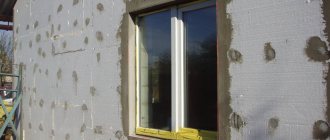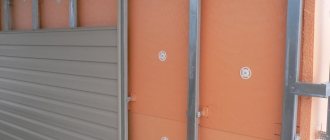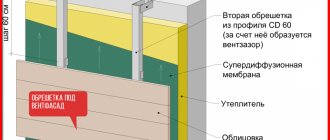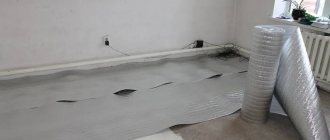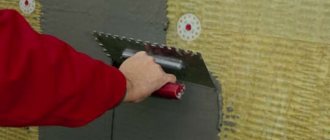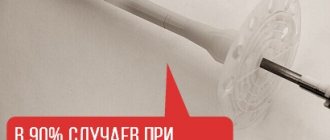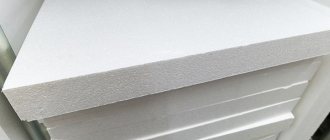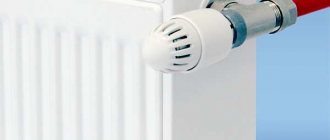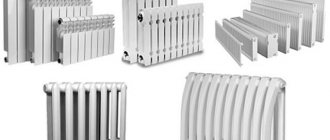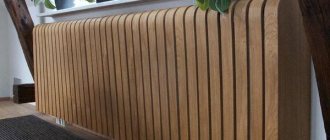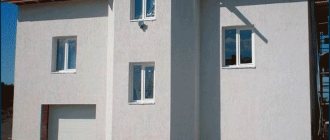Subtleties and nuances of installing thermal insulation
The basic methods for installing thermal insulation for various materials, such as polystyrene foam, penoplex or expanded polystyrene, are identical. All work comes down to a general algorithm, which has several stages:
- Preparation of the surface on which the material will be installed.
- Installation of sheet thermal insulation on an adhesive solution.
- Fastening the panels with fasteners.
- Refinement of panel joints.
- Installation of waterproofing film.
- Covering the insulated surface with decorative materials.
All work must begin with preparing the working surface, removing old paint, wallpaper or plaster, as well as eliminating wall imperfections. Next, the selected material for insulating the room is placed on a specialized solution, which should not contain toluene and acetone. The gluing mixture must be distributed evenly over the entire area of the element being installed.
For additional fixation and to prevent the sheets from moving, the first level from the ceiling is fixed to a metal profile. After the specified period for the adhesive solution to set, you can begin installing the fastening mushrooms. When drilling holes for them, the diameter of the drill is used, which corresponds to the diameter of the fungus stem. The depth of the hole should exceed its length by ten millimeters so that any debris left after drilling does not interfere with the installation of the fasteners.
Construction standards, codes and regulations
If you pay attention to the current legislation in the construction industry, it establishes standards and requirements for the installation of thermal insulation:
- When installing thermal insulation indoors or on the facades of residential one-story buildings outside, per square meter of insulation surface, it is necessary to place 4 elements for fastening in the corners and one in the center.
- At the corners of the walls you will need to additionally secure it with 6 fasteners.
- Provided that the height of the facade is from 8 to 20 meters, 7 fasteners will be required at the edges and one in the center.
- During installation work at a height of over 20 meters, the rules require one square meter of insulated surface to be attached to 9 elements.
The best option is to strengthen fungi at the joints of foam panels or similar material, since this method optimizes the number of holes in the insulation, which will not therefore affect the overall effectiveness of such measures.
If the fastening element needs to be fixed on a metal surface, for example, on corrugated sheeting, then a self-tapping screw is attached to the dowel leg and, together with the insulation, is pressed against the wall, after which the self-tapping screw is screwed into the metal. The depth of screw tightening must be at least 15 millimeters. Next, the joints of the insulating panels are additionally glued with aluminum reinforcing tape, and the corner joints between the walls, ceiling or floor are sealed with polyurethane foam.
Calculation of the required number of fasteners
For high-quality and durable installation of insulation, you need to use fasteners made in accordance with GOST, but also not forgetting to calculate the required number of such parts. The following formula will help for this:
D = T + K + I + Z, where:
- T - Thickness of the installed insulation.
- K - Thickness of the adhesive layer used to fix the panels
- I - The depth of screwing the self-tapping screw into the wall is at least 45 millimeters.
- Z - Possible inclination of the wall relative to the vertical, this parameter is optional.
The length of the dowel anchor for use on brick or concrete walls must be at least 60 millimeters. And if the brick or foam concrete block is hollow, then in this case it is at least 100 millimeters.
When choosing a fungus for installing thermal insulation, you need to take into account the characteristics of the specific insulation and surface.
Step-by-step insulation technology using fasteners in the form of fungi
Before attaching thermal insulation, it is necessary to place a vapor barrier material on the area of future insulation. Along with its immediate purpose, it will serve as an additional fastening.
Wall insulation
The installation process consists of simple steps:
- The entire area where the insulation is placed must be marked for drilling in increments of 0.8 m horizontally and 0.3 m vertically.
- Then the holes are drilled. The drilling diameter must match the mounting leg.
- Then the sleeve is inserted into this hole by hand. The core is placed in the sleeve and driven until it stops. At the same time, the umbrella opens with a special protection cover.
If washers are used, they are fixed to the plastic sleeve before installing the core.
To begin installing the insulation, you must first install a guide strip at the bottom of the wall. When installed, it will prevent the material from sliding down.
If the insulation is attached with glue, then the fungi are installed only after the glue has completely dried. The resulting joints between parts of the material are treated with polyurethane foam. You can also use foil tape if foam is used.
Calculation of the required number of fasteners is carried out according to the formula:
W (quantity) = S (coverage area) * Q (number of dowels per square meter).
The Q value for penoplex will be 4, and for basalt wool 6.
Substituting all the data into the formula, you get the required number of fasteners. You should always remember to have a reserve.
Thermal insulation of the base
The basement of any building must be properly insulated. Due to poor insulation of this part of the building, cold will enter the house through the soil and floor. Installation of thermal insulation is as follows:
- In order to begin attaching the thermal insulation, it is necessary to provide access to the surface of the base. It is best to carry out this operation at the stage of building construction.
- Mastic is applied to the surface, which promotes adhesion of the adhesive base.
- It is better to use polystyrene foam as a heat insulator. It is not affected by moisture. The glue is mastic, which will perfectly fix the insulation sheets.
- To insulate the base, you don’t need to spend money on fungi. The glued sealing material will be covered with soil in any case. This will ensure that the seal is pressed against the perimeter of the base.
- After gluing the material, the joining seams must be filled with foam.
The described algorithm of actions is quite simple, although it is considered more complicated than insulating walls.
Important! Only high-quality material is used for gluing.
Attic insulation
When insulating a house, special attention is paid to the attic. The preservation of heat in the house depends on the correct insulation. When installing insulation, rondole pressure washers are used.
There are several installation options depending on the material used for insulation:
Foam insulation
- In this case, the sheet width is chosen to be at least 100 mm. If a sealant with such a thickness is not at hand, then you can use a thickness of 50 mm, laying it in two rows. The installation work will be completed faster if the width of the material and the location of the rafters match.
- Polystyrene foam is installed using polyurethane foam or adhesive. If the product fits tightly to the walls of the rafters, then you can only walk along the edges of the seal (at the connecting joints). In this case, the foam will serve as an additional connecting element.
Key features of dowels
- Such fasteners for thermal insulation and other facade structural elements have a distinctive feature - an elongated rod. It is designed for high-quality fixation of materials and stability of the dowel itself in the structure. Dimensions of 10x100 millimeters or more allow you to secure building materials with a wide cross-section.
- For the manufacture of dowels, special materials are used that are not affected by corrosion, atmospheric phenomena, or mechanical deformation. The dowel is often made of nylon or frost-resistant polypropylene; the screw is a rod made of galvanized steel.
- The temperature range at which façade fastening elements can function normally is from -40 to +80 degrees Celsius.
- Despite the impressive operating temperature range, it is better to install thermal insulation and work with screws and dowels at air temperatures above 0 degrees Celsius.
- Installation of thermal insulation fastening elements and other façade components is carried out as standard. A hole is made using a drill, an expansion dowel is inserted, and then it’s up to the screw, which is mounted with a screwdriver or screwdriver.
- When it comes to installing cladding materials, the sides of the dowel are recessed into the seam between the cladding elements.
Where are they used?
We can say for sure that facade dowels are not limited to their use exclusively in the construction of a ventilated facade, installation of metal profiles and fastening of facade facing materials.
In fact, fasteners of this kind serve perfectly well when installing window frames, windows themselves, doors, wall cabinets, gates for private houses, and all kinds of structures made of wood.
How to choose
To organize the installation of thermal insulation and use the screw correctly, you will need to choose the right façade fastener suitable for your specific purposes.
Therefore, listen to a few useful tips that will allow you to make the most correct choice, correctly organize the work process, and be sure that the installation of the facade or facade elements was carried out correctly.
- What is the outer wall made of? Today, the market for construction and finishing materials offers a wide range of dowels designed for specific materials in which they will be mounted. We are talking about concrete, foam concrete, brick, gas silicate, wood, polystyrene foam, etc.
- What insulation is used and what it is made of. The thermal insulation material and its size influences which dowel and screw you will ultimately use. If we are talking about mineral wool, then a metal facade fastening element will come in handy here. For thermal insulation of less weight, a plastic analogue with impact-resistant characteristics may well be suitable.
- Material thickness. Take careful measurements to understand how deep the dowel will go into the façade material. The most common size of the fastening element is the facade dowel 10x100 millimeters. But it is not universal, so in some situations it may be too short, and for others it may be too long.
- Features of the climate of your region. Air temperature, humidity, and wind will exert pressure on the façade dowel with screw. In strong winds, weak plastic dowels simply cannot withstand the load, causing your entire façade insulation and insulation structure to collapse.
- 5 The height of the building on which façade work is being carried out. There is a fairly simple principle of choice here - the higher the building, the stronger the dowels should be. Deciding on such a nuance of a purchase is clearly not difficult.
- 6 Cost. Price should not be the determining factor, since low cost indicates appropriate quality. But dowels themselves are not an expensive pleasure, even if they are made of high-quality materials. On average, the price for a package of facade dowels is from 150 rubles. This package contains 100 elements. That is, to cladding a new façade structure of a small private house, you will need literally 2 packages of fasteners. 300 rubles is definitely not a huge amount of money.
Facade fasteners actually play a more significant role in achieving the final result than you think. They are responsible for the reliability of fastening and fixing the thermal insulation, waterproofing, and cladding layers of the renovated walls of your home. Therefore, take a responsible approach to the choice of screws and dowels, and do not skimp on such inexpensive components.
Varieties and description
There are several types of fungi; the domestic manufacturer (TechnoNIKOL, Facade-Komplekt) offers the following types of dowels for fastening insulation boards:
1. Plastic.
In the manufacture of disc clamps, polypropylene, polyamide, and nylon are used. They are low cost, resistant to aggressive environments, have good adhesive properties, but are not suitable for all walls due to their strength characteristics. Used for brick, concrete, stone. The main difference is the conical holes in the caps, which ensure a reliable fit and long-term operation of the insulation. Energy conductivity is 0.005 W/K, the fungus is established at temperatures from -40 to +80°C. Withstands loads of 20-400 kg. It is recommended to work with rolls that are light in weight; heavy cladding should not be laid on top.
2. Mushrooms with a metal anchor.
The fastening consists of an iron nail with a wide head and a spacer. The raw material used in production is polypropylene, which is resistant to mechanical stress. The galvanized core is coated with an anti-corrosion compound. They are several times stronger than their plastic counterparts, but their use is limited due to the high energy conductivity inherent in metal. The fastening is suitable for installing insulation on thin-walled and hollow structures (gas silicate, foam blocks). The maximum load during operation reaches up to 800 kg, the fungus can withstand temperatures from -50 to +60°C. Any cladding is acceptable, including a heavy plaster layer with reinforcing mesh.
3. Fasteners with thermal head.
Such fungi are similar to fasteners with a metal core. The difference is a special coating on the cap, which has a low conductivity coefficient, which allows you to avoid cold areas when laying insulation. The material for the head is heavy-duty polyamide, with a parameter of 0.025 W/μ. The dowel is protected by a polymer case, which prevents moisture from entering. Suitable for installing insulation on wooden surfaces, gas and foam concrete, solid brick, stone.
Installation nuances
To ensure a reliable fit of the thermal insulation, it is necessary to calculate the fungi parameter for insulation. Calculations are made using the standard formula Q=T+S+D+H, where the first letter is the thickness of the material, the second is the height of the adhesive layer, the third is the length of the fastener recess into the wall, the fourth is the deviation from the plane in case of surface unevenness (used when necessary). For example, to protect a facade with 50 mm thick insulation, all the numbers are added, resulting in a fungus 100-200 mm long. When installing on hollow and cellular structures, porosity must be taken into account.
The principle of adhesion of the fungus to the surface lies in the laws of friction, due to which the diameter of the core of the installed fastener expands, eliminating reverse motion. The spacers on the body are presented in the form of small protrusions. They fit freely into the base, but the sharp edges prevent them from falling out. The holes in the cap also help ensure a secure fit, ensuring a tight fit to the mat. All work on attaching protection to facades consists of the following steps:
- Preparation of the base, cleaning of old coatings.
- Sealing cracks, eliminating defects.
- Degreasing.
- Installation of a metal profile under the first row to prevent the mats from slipping.
- Laying slabs on a special adhesive mixture.
- Drying the composition.
- Fastening with mushrooms.
- Processing of joints.
According to building codes, there are rules that require a certain number of dowels. For arranging interior walls and facades of low-rise buildings, an envelope fastening method is suitable: 4 units around the perimeter and 5 in the center. At the corners of the house you will need 6 pieces, located parallel to each other. For facades up to 25 m high, 7 umbrellas per m2 of insulation are chosen. When finishing multi-storey buildings, 9 fungi are counted per 1 m2.
Prices
The cost depends on the type of umbrellas, their size and quantity. The volume and parameters of thermal insulation also play a role. You can save money if you buy products in bulk. Prices from the manufacturer TechnoNIKOL:
| Name | Type (plastic, metal, thermal head) | Dimensions, mm | Price per unit, rubles |
| LFN | T | 10x140 | 10-12 |
| LFM | P | 10x100 | 3-5 |
| LFMW | m | 10x90 | 6-8 |
| LFT | m | 10x200 | 8-10 |
| LIM | m | 10x180 | 10-12 |
| LIR | P | 10x160 | 6-8 |
| LIT | P | 10x200 | 7-9 |
| LMX | T | 10x200 | 12-15 |
| LTX | P | 10x140 | 5-7 |
When installing insulation, the use of special fasteners is required. Fungi come in different types and are used to fix insulating materials to wood, stone, concrete, brick and porous surfaces.
Calculation of flow and length
When attaching insulation to 1 m2 of surface, from 4 to 10 products are required; for more accurate information, contact the supplier: each type of nail has its own size. It is not economically feasible to exceed the number of fungi; in addition, any additional hole reduces the overall thermal resistance of the house.
The length of the leg of a disc nail is determined as the sum of the thickness of the thermal insulation, adhesive composition, the size of the spacer part (minimum 40 mm, the value depends on the type and is specified in advance), and the deviation of the working surface from the vertical. Preliminary calculations should not be neglected; fungi for attaching insulation are cheapest to buy in bulk, but there is a risk of purchasing a large batch of unsuitable products.
| Name of fungus, purpose | Dimensions, mm | Maximum insulation thickness, mm | Minimum hole depth, mm | Price for 1 piece, rubles |
| Dowel with a propylene cap. For adhesion to stone and concrete | 10×80 | 50 | 40 | 3 |
| 10×110 | 60 | 55 | ||
| 10×180 | 130 | 60 | 5 | |
| Dowel with a galvanized steel rod for fastening polystyrene foam and layered insulation to concrete and brick bases. The connection is made by mechanical driving | 10×90 | 60 | 40 | |
| 10×120 | 70 | 55 | 6 | |
| 10×300 | 240 | 70 | 20 | |
| Mushroom dowel made of polypropylene with a metal thermal head, for attaching thermal insulation using the “wet facade” technology | 10×80 | 50 | 40 | 7 |
| 10×140 | 100 | 55 | 10 | |
| 10×220 | 160 | 70 | 15 |
Disc-shaped dowels for fastening thermal insulation
To fasten thermal insulation made of expanded polystyrene, mineral or glass wool, special devices in the form of fungi (known as “umbrellas”, facade or disc dowels/nails) are used. The basis for reliable adhesion is the usual friction force; this fastener is used only once. As a result, the requirements for site preparation and installation are increasing. An important factor is the consumption of material and its dimensions (preliminary calculation is recommended); if a smaller number or unreasonably short parts are used, the thermal insulation will not hold up.
Distinctive features of the fungus are a wide cap and an expandable long leg, fixing the slabs in a vertical position when insulating walls or in a suspended state during roofing work. This is the only type of construction fasteners that goes completely deep into the facade. The dimensions of the core and sleeve of the fungus depend on the thickness and properties of the insulation (from 80 to 300 mm), the diameter of the cap is standard - 59. Spacer notches with sharp edges on the body contribute to the reliability of fastening; they face the plate and do not allow the dowel to come out of the wall. The quality of fixation is affected by the thoughtfulness of the holes on the cap (or roughness), which are literally pressed into the insulation.
Dowels with a disc head are suitable for many materials, regardless of their density and structure. Modern fungi for fastening insulation are not subject to corrosion and thermal influences, they are absolutely non-flammable. The raw materials are: for the head - low-density polyethylene (polypropylene), for the wedge - galvanized steel or polyamide. Wide nylon plates - rondoli - are sometimes used to attach soft insulation, but impact-resistant plastic is still preferable. The exception is installation and operation at abnormally low ambient temperatures, in which case polypropylene becomes brittle and breaks down.
Depending on the type of cap and material, fungi are distinguished with:
- plastic anchor;
- metal rod;
- thermal head.
The first ones are made entirely of polypropylene; a distinctive feature is the conical holes on the cap to improve the quality of adhesion. Such products have minimal thermal conductivity (≤0.004 W/m∙K), do not create “cold bridges”, can withstand temperatures from -40 to 80 °C and a load-bearing load of 20–380 kg/m2. Plastic anchor mushrooms are suitable for attaching lightweight insulation to concrete, brick and stone walls. The price is low, they are not subject to corrosion, but are of little use for installing heavy insulation.
Metal anchor mushrooms have a steel nail (galvanized or heat treated low carbon). The spacer elements and cap of this type are made of impact-resistant polypropylene, the sizes are slightly larger than the others. They cope with differences from -55 to 60 °C and load-bearing loads of up to 750 kg/m2. Disadvantages include the appearance of “cold bridges”; advantages include adhesion with heavy thermal insulation.
Dowels with a thermal head are worth buying for attaching insulation boards to a wooden wall. The end of the steel wedge is fitted with a small plastic part to reduce heat loss. Such fasteners can withstand loads of up to 920 kg/m2. Their cost is high (up to 30 rubles per piece), but this is compensated by minimal heat loss and chemical resistance.
To properly fasten the insulation with fungi, the following operations are performed sequentially:
- Calculation of length and consumption.
- Marking for future fasteners. Maximum permissible step: horizontally - 80 cm, vertically - 30.
- Preparing the seat: drilling holes in the insulation and the wall with a diameter of 10 mm to a depth that is 5–10 mm greater than the length of the fungus stem.
- Pressing in the dowel until the cap and insulation are completely joined. In this case, a hammer is not used; the work is carried out manually.
- Inserting a nail and driving it until it finally hits the wall.
- Closing the cap with a protective lid with fixation in the center.
Characteristics
Each product item from the list above has its own unique properties and each has its own positive and negative qualities. Before purchasing a sufficient amount of fastening material, you need to familiarize yourself with the characteristics of each type of disc dowels:
- Disc-shaped dowel with plastic nail. It is made from nylon, low-density polyethylene or polypropylene. In terms of their properties, these materials are virtually identical, so they should not affect a positive decision when choosing fasteners. Since this fastening material is made entirely of plastic, it is very light, which allows it to be used in any structure without worrying about the load on the load-bearing wall. But there is also a downside to this - you shouldn’t use them to attach heavy insulation, they simply won’t withstand it.
The absence of metal in the composition of the expansion nail gives it additional advantages - immunity to moisture and poor thermal conductivity. The first advantage makes it impervious to corrosion and increases service life to 50 years, and the second allows it to minimize heat loss. At the same time, during installation, extreme care must be taken when working with a plastic expansion nail. Possessing low rigidity, it has the unpleasant feature of bending and breaking at the most inopportune moment.
- Disc-shaped dowel with metal nail. It differs from the previous model in that it uses a 6 mm thick galvanized steel metal nail as a fastening element. This significantly increases strength and allows you to withstand the weight of any structures and use them when working with any type of insulation. And unlike plastic, a metal expansion nail will not break or bend. But this type of disc dowels also has disadvantages. A metal expansion nail conducts heat better than a plastic one and can create areas where the wall can freeze, which will not happen with a dowel made entirely of plastic. The second drawback is corrosion. If the wall remains wet most of the year, then the rust will eat through the entire expansion nail through the unprotected head, which will lead to failure of the entire thermal insulation system.
We recommend: Shut-off valves and requirements for them
- Disc-shaped dowel with a metal rod and thermal cover. This is an improved version of the previous fastener, designed to work in conditions of high humidity. The main difference is the plastic plug that is attached to the dowel head. It prevents the penetration of moisture and reduces the outflow of heat, so such fasteners can be considered more airtight. There are two versions - with a removable plug, which you need to install yourself, and a plug installed at the manufacturer. The second option is more convenient to use, because the plugs are quite small and are stored separately. It is quite easy to lose them during work.
- Facade dowel with fiberglass rod . This species appeared on the market relatively recently. It is assembled from the following elements - a clamping part, a fiberglass rod, an anchor element with a spacer zone and an expansion washer, which fits onto the clamping part to create an additional area for fixing the insulation. Thanks to the fiberglass rod, the dowel has high strength and low thermal conductivity. All these elements can be selected separately, guided only by the required dimensions.
A quality certificate for thermal insulation panels must be present. Today, types such as fungi and umbrella are often used. The mushroom can be screw, IZL-T and IZM.
Other advantages and design of the mushroom
In addition to these advantages, this type of fasteners for insulation is able to resist corrosion and be comfortable during the installation of insulation material. Such fastenings are not subject to thermal influences and fire due to the impossibility of ignition of the material.
The use of dowels in the form of fungi extends to insulation materials with different insulation technologies, different densities and structures.
Moreover, these elements, which are simple in design, have good potential for attaching insulation to surfaces made of different materials - wood, plastic, stone, brick and concrete.
The design of this fastener is quite simple and consists of three components:
- Wide diameter hat
- Durable core
- Sleeve
The connection point between the head and the sleeve can have a different transition configuration or a direct direct joint.
Types of fungi for attaching insulation
Although the design of the fastening fungus is quite simple, there is still a classification of these parts. They differ in the type of material from which they are made, as mentioned above. They also differ in the method of fastening:
- Mushroom dowels with core
- Fastening mushrooms with threads that can be driven into the insulation material or wall
Differences may also relate to the type of material. Fasteners for plastic insulation can be made of polypropylene or nylon-based.
Modern technologies in the field of insulation have stepped far forward. One of the achievements can be considered - polyurethane foam insulation, which is not only very convenient and easy to install, does not require lathing, saves space, but most importantly retains heat well.
Calculation of fungus length
The quality of fastening will depend entirely on the correct length of the fungus. Calculating this value is not at all difficult, but even if you don’t want to make calculations using the formula, you can take a simpler route.
You can add 5 cm to the thickness of the insulation being reinforced, calculated for the depth of entry into the insulated surface. Another 1 cm can be added based on the thickness of additional insulators and coatings.
A more correct calculation can be made using the formula:
S=X1+X2+X3+X4
The symbol S here denotes the rationally calculated length of the fungus. The symbols X1, X2, X3, X4 indicate, respectively, the thickness of the insulation layer (X1), the thickness of the layer of plaster, waterproofing or adhesive base (X2), the depth of entry into the insulated surface (X3), and the reserve for a possible slope of the insulated surface (X4).
Operating principle of insulation fastening
The main role in ensuring the functional practicality of this type of fastening elements for insulation is played by the physical principle based on the force of friction. Thanks to it, the reverse movement of the fungus is simply impossible. During its installation, the diameter of the sleeve expands and cannot go back.
In addition, the quality of fastening is also facilitated by the presence of spacers on the body of the fungus. They usually look like small protrusions on the body of the case, facing towards the head. They freely enter any prepared surface, but their sharp edges directed in the opposite direction do not allow them to come back out.
The retention of the insulation is also facilitated by special holes on the cap of the fungus, which tightly fix the insulation, literally pressing into it.
Such a simple design of a fastener in the form of a fungus, however, can ensure many years of reliable operation of insulation reinforced with this means. And the ease of installation and reasonable price of fungi for attaching insulation have made them very popular.
Video instructions for attaching foam plastic with a fungus
Polystyrene foam is a very thick insulation material, the fastening of which can only be reliable using a special dowel-umbrella. You can see an example of attaching foam plastic as insulation in the video.
Rules for installing fungi
The disc dowel is designed for final fixation of the heat insulator, so installation is carried out after the insulation is already on the wall. Polystyrene foam, extruded polystyrene foam and mineral wool slabs are initially attached to the wall surface with a special cement-based adhesive, while mineral wool rolls are placed in frames. And after that they are fixed with disc-shaped dowels. Ideally, installation of insulation and dowels is best carried out at an ambient temperature of 0°C, approximately in the middle of the operating range.
Installation is carried out in the following sequence:
- Installation locations are marked
- In the designated places, holes are drilled with a hammer drill directly through the insulation. The diameter of the drill must match the diameter of the dowel. The depth of the hole should be equal to the length of the dowel plus 10-15 mm.
- Next, the dowel is inserted into the hole until the cap of the fungus comes into contact with the insulation and is pressed tightly; finishing with a hammer is not required.
- The core is inserted into the dowel and hammered in until the fungus is finally fixed in the wall.
You need to purchase disc dowels from trusted retail outlets with a solid reputation and only under the trademarks of well-known manufacturers. In small businesses, it is popular to produce such products using injection molding machines in garages from recycled materials, and the quality of the products does not always meet the standard. Such dowels not only may not be able to cope with the load during operation, but even at the installation stage they crack and crumble. It will not be possible to pull out an under-filled dowel due to its design - the barrel is equipped with tendrils, you will have to cut it off, spoil the insulation and drill a new hole for a new dowel.
Insulation of external walls
Let's look at the most popular:
- Polystyrene. This material is very light and compact. Reasonable price, ease of installation and environmental friendliness are the main advantages of expanded polystyrene (polystyrene). Thanks to the production technique, it has low thermal conductivity. The only drawback can be considered low vapor permeability.
Please note: you should take into account the fact that a wooden house breathes and allows moisture to pass through, and polystyrene foam attached close to the wood will prevent the removal of fumes, which can lead to dampness and mold
Thanks to the presence of antiseptic and glue impregnation, ecowool is not afraid of rodents and other insects. Research has been carried out on the thermal conductivity of wool: a layer of 10 cm of wool is equal to a wooden beam 40 cm wide. The advantage of insulating walls from the outside is obvious - saving space inside the house is about 10% of the total area.
3. Mineral wool. Mineral wool is a natural insulation material that comes in the form of slabs. It is convenient to install; however, you should wear a construction mask while working, since the mineral wool insulation contains small dust particles.
It should be remembered that brick requires an additional strip foundation around the entire perimeter of the house.
Between the wooden house and the brickwork, it is necessary to leave a distance of 20 cm to ventilate the facade, in order to avoid the appearance of black fungus.
Please note: since brick or stone is the heaviest façade material, a mesh of reinforcement is attached to the foundation. 5
Basalt insulation. Natural insulation with long and elastic fibers glued to each other. It has good thermal conductivity and a low degree of flammability. Flexible and lightweight basalt, well protects a wooden house from drafts and freezing
5. Basalt insulation. Natural insulation with long and elastic fibers glued to each other. It has good thermal conductivity and a low degree of flammability. Flexible and lightweight basalt protects a wooden house well from drafts and freezing.
Types of thermal insulation materials
Materials for building insulation that prevail in the modern construction market:
- polystyrene foam is a popular material used for wall insulation;
- penoplex slabs are a “relative” of foam plastic, in terms of production they are higher than foam plastic;
- expanded polystyrene is a porous material that is used to insulate floors, walls, and various partitions;
- glass wool is an excellent material for insulating floors and ceilings;
- slag wool - blocks heat well, but due to fear of moisture and poor quality it is not widely used;
- mineral wool is an environmentally friendly material, ideal for insulation inside the house;
- ecowool - this material is perfect for insulating the walls of residential and private houses; it is also an environmentally friendly material;
- polyurethane foam attaches well to all painted surfaces, metal, brick, glass, wood, concrete, and is perfect for insulating ceilings, walls and floors;
- reflective thermal insulation (foil) – is a layer of reflective material 2 cm thick.
Mounting methods
The choice of fixation method depends on several factors. One of them is the base of the surface: concrete, brick, wood or aerated block.
- The glue is used in a dry composition, which requires preliminary preparation: a mixing container, a construction mixer, spatulas. For outdoor use, certain brands are used that meet all the requirements: frost resistance, moisture, temperature changes, maximum heating.
- Liquid glue in cans is applied using a construction gun. It must also have features: percentage of adhesion, attitude to moisture, service life.
- Dowel umbrellas. There are 3 types: plastic, with a metal pin, with a metal nail and a thermal head. Mostly polymer products or those with a thermal head are used.
- Lathing. They are created extremely rarely due to the properties of the tree. Attitude to moisture, temperature changes. Sometimes the sheathing is made from metal profiles. They are galvanized - this is an advantage, since water does not affect them, as does the temperature.
- Insulating plasters are also used. They are applied in 3 layers on a reinforced mesh (facade).
Dowels to a concrete wall
Dowels are used to glue thermal insulation to concrete. There are 2 parameters by which you need to choose dowels:
- The base is hollow and porous. Based on the concrete base, the load-bearing capacity of the fasteners is calculated.
- Fastening type. Plastic fasteners are not designed for heavy loads.
The dowel is firmly attached to the concrete thanks to the antennae located along the rod. They straighten out in the concrete cavity after screwing in the nail (core). There are also dowels, the core of which is not screwed in, but driven in.
To fix the insulation on a concrete base, it is necessary to carry out preparatory work:
- Clean the surface from old coating - lime, chalk, paint. If there is plaster, it needs to be examined.
- If there are protrusions on the surface, remove them with a power tool. The cracks are filled, reinforced, and plastered.
- The surface with mold is dried, cleaned and treated with special products.
- After the work is done, the surface is coated with a primer.
The preparatory process is over.
Now, at the bottom you need to fix a wooden auxiliary strip or a galvanized profile. It will hold the insulation and prevent it from “sliding” down.
Fungi to a brick wall
Installing tile insulation on a brick surface is similar to working on a concrete base. The algorithm of actions is as follows:
- Surface preparation. Checking it for evenness.
- Surface treatment with primer.
- Insulation boards - polystyrene foam, penoplex, expanded polystyrene - are coated with an adhesive solution. Either use a notched trowel and apply glue evenly over the entire surface, or dot application - place dots of solution in the corners and in the center.
- A holder bar is fixed at the bottom of the wall. Install insulation boards.
- After the glue has set, each slab is additionally secured with dowels in the corners and in the center.
- All joints of the slabs are covered with the same solution.
- The last step is covering the surface. Decorative plaster or finishing materials.
Other mounting methods
Roll insulation – mineral wool, a often used material in insulating wooden buildings. A frame is needed to attach it. Warming is carried out as follows:
- Fix the vapor barrier film.
- Install a control strip at the bottom of the wall.
- Along the width (slightly smaller) of the insulation, fill horizontal or vertical wooden slats, which will be higher than the thickness of the insulation.
- Cotton wool is placed in the resulting niches.
- A windproof membrane layer is created on top.
The denser the cotton wool is laid, the fewer cold bridges there will be.
Another option for fixing the insulation is gluing the material without the use of adhesives - these are self-adhesives. Let's say penofol. A rolled material with a sticky inner side for gluing to a surface. To do this, the surface must be treated.
Disc mount
The disc-shaped dowel is used for soft insulation, so as not to damage the material
The dowels that are used to install insulation have a specific shape. They are also called fungi or umbrellas. Fasteners allow you to securely fasten even the most fragile materials. With their help you can attach thermal insulation to concrete, stone, brick.
Positive aspects of the disc mount:
- Reliable adhesion to the surface, which is ensured by a wide cap of the fungus.
- Withstand significant loads.
- To improve adhesion, a rough part is made on the surface of the cap.
- Anti-corrosion resistance.
- They are made of inexpensive plastic with good characteristics.
- Does not damage the seal. The umbrella is a bendable element.
- Reinforcement of the retainer structure due to expansion of the dowel in all directions.
Plastic fasteners
Plastic dowel made of polypropylene
Plastic holders are the cheapest, but their quality does not deteriorate. The surface of the umbrella has cone-shaped holes for extra grip. To install non-solid materials, use nylon fasteners made of high quality polypropylene.
Features of plastic mushrooms:
- Low cost due to simplicity and low cost of production.
- They do not respond to temperature changes.
- Low level of thermal conductivity.
- Ability to work in harsh conditions.
- They do not rot or rust.
- Capable of withstanding a load of 400 kg/sq.m.
Such products are actively used for installing insulation on brick and concrete surfaces.
Metal fasteners
Dowels with an iron core are not recommended for use in high humidity
The nail for fastening is made of steel. The sleeve is made of polypropylene with spacers located at the end. This design allows you to increase the load level. The main area of use is the arrangement of building facades. The disadvantages include:
- High cost of products.
- Risk of rust formation upon contact with water.
- The appearance of condensation.
How to attach basalt insulation to a wall for facade thermal insulation?
Let us consider in detail how to attach basalt thermal insulation to walls in plaster facade systems:
- Preparing the base . Basalt insulation slabs are glued to the walls, so their surface must be fairly flat. To do this, repair chips and potholes. Before fixing the basalt wool, priming is performed to strengthen, remove dust from the structure and improve adhesion.
- Gluing mini-slabs . Why are special adhesive compositions selected, designed to both attach basalt insulation to the walls and ensure its tight fit to the surface. Such dry mixtures ensure maximum adhesion of thermal insulation to brickwork, concrete walls and other surfaces, have frost resistance of the hardened layer, and special modifications make it possible to attach mini-slabs at sub-zero atmospheric temperatures. The glue is applied according to a special scheme, carefully working out the perimeter and applying the composition in the middle, after which the slab is pressed to the surface. The position of the miniplates is maintained using a level. After installing the first row, the second is fastened with staggered seams so that the joint of the slabs falls in the middle of the bottom line of the slabs. The rule must be followed for all subsequent stripes.
- Doweling . The basalt insulation should be attached to the wall using disc-shaped dowels after a certain time allowed for the glue to dry. Then all work is carried out both on the installation of plaster and decorative layers, and on the final painting of the facade.
To understand the intricacies of attaching mineral wool slabs to facade walls, we invite you to watch a video about installing a thermal insulation system.
Facade insulation using technology with a ventilated gap has a slightly different approach to fixing basalt wool.
- Installation of a vapor barrier . A special film coating that supports the removal of moisture and fumes from the walls of the house.
- Frame structure . The design feature of the ventilated façade involves installing the finishing at a distance from the insulation, so initially a rigid frame system is installed from a profile resistant to corrosion and mechanical loads.
- Laying slabs . It is quite simple to lay mini-slabs between the frame guides. Having chosen products with a certain rigidity and insulating properties, they are installed with light compression of the edges. After leveling, practical basalt insulation for the facade fills the allotted space, which ensures sufficient fixation strength.
- Doweling . Supporting disc dowels must be installed according to the pattern and quantity specified by the slab manufacturer or system designer. Particular care should be taken to attach two-layer thermal insulation due to its increased weight.
- Installation of a hydraulic barrier . The membrane is able to protect thermal insulation from drops of water condensing in the air gap of the ventilation facade.
After proper fixation of the mineral wool insulation, the sheathing is installed, space for ventilation is maintained and decorative finishing is installed.
To understand how to attach basalt insulation to a wall, you need to decide on the method and design of the thermal insulation system. The selection of fasteners, adhesive mixtures and other structural elements of the system will be carried out by specialists and professionals in the field. For free consultation and assistance in matters of effective wall insulation, please call +7 (495) 565-39-92 .
During construction, various types of fastenings are used: self-tapping screws, nails, metal staples, etc. A disc-shaped dowel is used to fasten the insulation.
